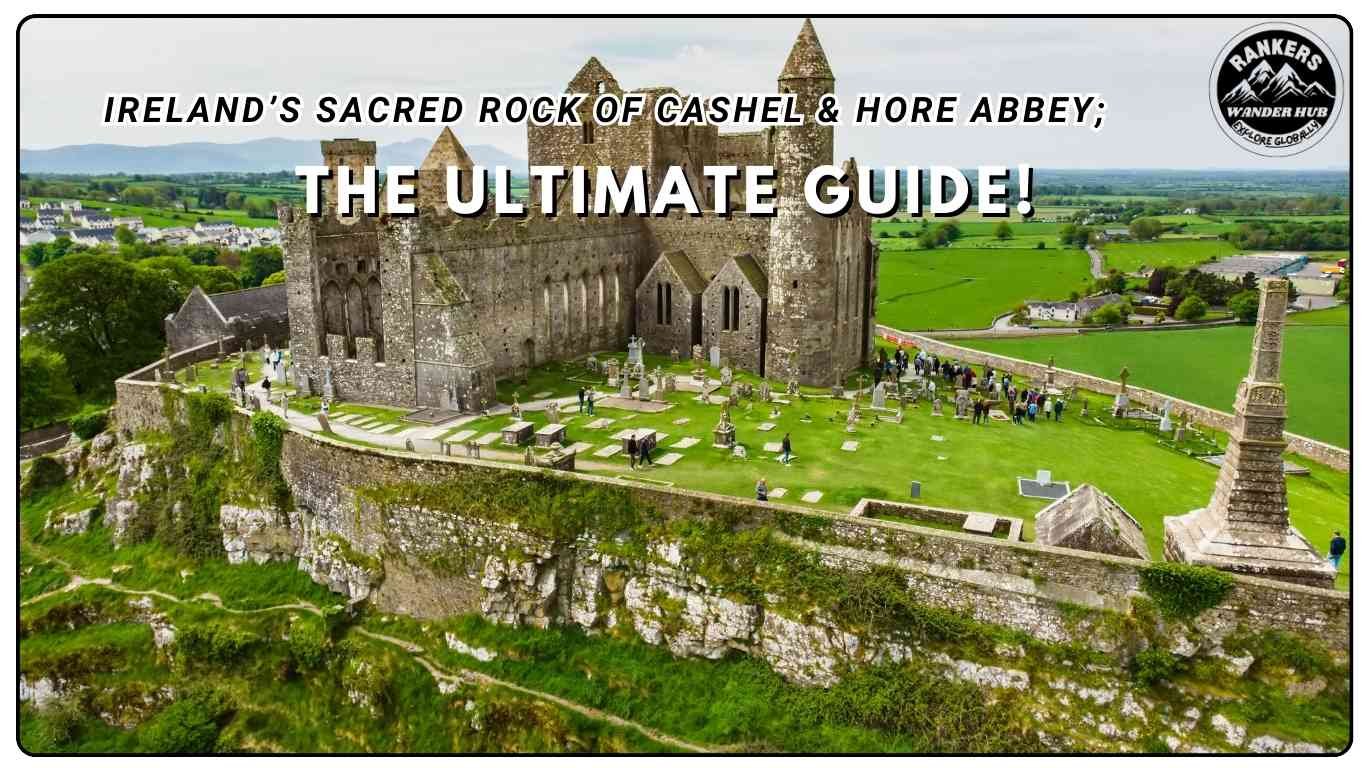Overview and Attractions of the Rock of Cashel and Hore Abbey:
Explore the heart of Ireland through the Rock of Cashel and Hore Abbey. In this guide, we’ll dive into these amazing places that capture Ireland’s rich history and medieval architecture. Both landmarks are iconic tourist attractions in County Tipperary and hold stories from centuries past. Let’s take a closer look at their unique features and significance.
The Sacred Past: Rock of Cashel and Hore Abbey
The Rock of Cashel sits high on a limestone hill and is often called St. Patrick’s Rock. This majestic spot dates back over 1600 years and served as a defensive center and royal fortress. Rising above medieval ruins, it’s not just a national monument but also an archaeological wonder. Visitors can see elements of Celtic art and medieval architecture, giving it an eerie, almost otherworldly feel. The walls and height of the complex tell of its power and resilience.
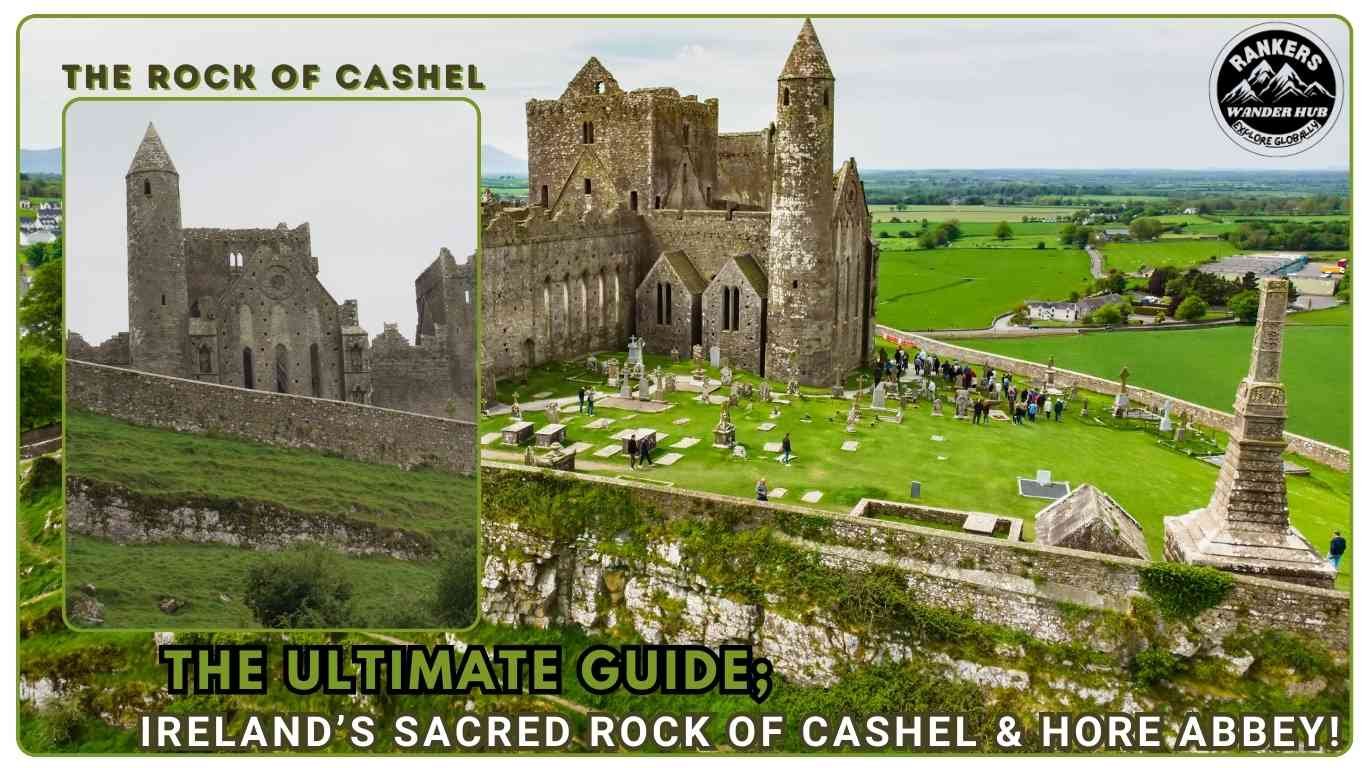
Just below the Rock lies Hore Abbey, nestled in a cow pasture with crumbling stones and a peaceful aura. Despite its quieter setting, the Cistercian monastery has an eerie charm and thriving history. The abbey’s Gothic church, tower, and square cloister add to its appeal, especially for those interested in Ireland’s Christian heritage. It was fascinating to stand where Benedictine monks once lived, feeling the age-old walls that have witnessed countless seasons and stories.
Historical Significance: From Kings to Conflict
The history of the Rock of Cashel spans centuries and weaves tales of kings, warriors, and religious leaders. The King of Munster once ruled from this hilltop, and it became a place of ecclesiastical power in southern Ireland. One of the most famous figures associated with the Rock is Brian Boru, the High King of Ireland in the 10th century, who used this spot as a fortification.
The Eóganachta dynasty also played a major role here, with rulers like Conall Corc and Eógan Mór leading the kingdom and shaping the land. This dynasty brought sophistication and a unique lore to the area, with stories of Irish royalty and gentle governance that led to economic prosperity.
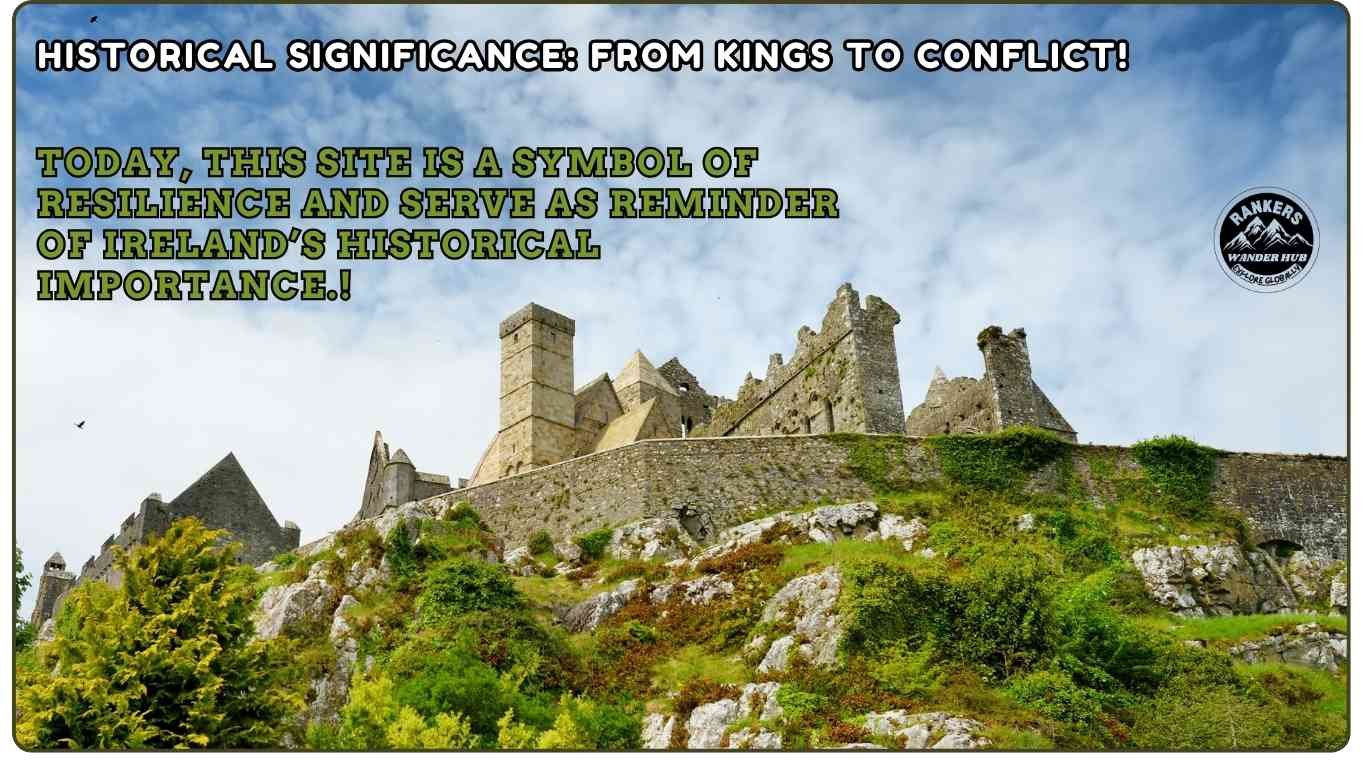
In the 16th century, the Reformation brought turmoil and led to a decline in the Rock’s religious importance. The 1647 massacre during the Irish Confederate Wars left a lasting impact, as English Parliamentarian troops under Murrough O’Brien, the Earl of Inchiquin, attacked, leading to the destruction and looting of religious artifacts. Today, these sites are symbols of resilience and serve as reminders of Ireland’s historical importance.
Echoes of Faith and Legacy
The Rock of Cashel also stands as a religious stronghold. St. Patrick himself is said to have baptized King Aengus here, bringing Christianity to Munster. The Christian significance of the Rock is immense, with it being the ancestral seat of Ireland’s church leaders. Arthur Price, an Anglican Archbishop, helped with preservation efforts in later centuries, protecting these sites for future generations.
Both the Rock of Cashel and Hore Abbey hold a unique place in Irish history. Their ecclesiastical dominance and secular power highlight their role as both spiritual sites and fortresses. Whether you’re a history lover or a casual visitor, these sites promise an experience rich in heritage and Irish lore.
Unique Architecture and Key Structures
The Rock of Cashel and Hore Abbey boast striking medieval architecture that draws visitors from around the world. The Gothic church in Hore Abbey includes a square cloister and an ancient limestone complex. This abbey was once a place of quiet prayer and remains an impressive symbol of early Christian life in Ireland. Wandering through the arches and collapsed walls, you’ll feel the deep introspective experience of this once-thriving place.
At the Rock of Cashel, the impressive Cormac’s Chapel showcases Romanesque architecture with beautiful stone carvings, pillars, and frescoes depicting biblical scenes. The nave and chancel inside create a sense of grandeur, with twin towers and a unique façade. A special feature is the chapel’s calcified lime wash and UV germicidal treatments used for mold control, keeping the delicate artwork in top condition. Preservation of this delicate environment is essential to maintaining the intricate design of this historical treasure.
The Round Tower, standing 28 meters tall, is one of the oldest structures here, with its early medieval bell tower and conical stone roof. Its lintelled windows once served as a refuge during turbulent times. The Gothic cathedral, cruciform in shape, includes a central tower, choir, and transepts, with stunning sandstone and lancet windows. The cathedral’s sedilia and piscina add to its intricate design, while columns and tombstones capture a sense of medieval grandeur.
Another intriguing spot is St. Patrick’s Cross, crafted in a unique Latin style with a cross head featuring a minotaur—a symbol that adds both artistry and mystery to the site. This cross connects visitors to Ireland’s medieval history and early Christian era. Don’t miss the Hall of Vicars Choral, a residence with a timber gallery, often highlighted for its Sheela-na-gig carving, which offers a touch of historical intrigue.
These sites are more than just beautiful views—they offer panoramic perspectives of Ireland’s countryside. Seeing the Rock of Cashel at sunrise or sunset brings out the solitude and natural beauty of the area, making it perfect for quiet reflection.
Practical Tips for Visiting
To enjoy the Rock of Cashel fully, a few travel tips can help. Ticket prices vary, so check for admission details and consider online booking to secure guided tours. Tours are about 45 minutes, but you may also explore as a self-guide if you’re on a tight schedule or short notice. Times vary, so be sure to confirm, especially if you wish to tour Cormac’s Chapel.
Accessibility can be a factor, as the site includes steep paths and uneven terrain. Wheelchair access is available in some areas, but wearing sturdy footwear is a good idea due to the rough ground. Toilets and visitor amenities are located conveniently around the site, and there’s plenty of parking. If you’re planning a day trip, other attractions like Blarney Castle, Cork City, and Cahir Castle are nearby.
The best times to visit are between mid-March to early October when the site is open daily from 09:00 with the last admission at 16:45. From mid-October to mid-March, closing time is slightly earlier at 15:45. The average visit takes about 1 to 1.5 hours, though weather can be unpredictable. Irish weather calls for layered clothing, a raincoat, or umbrella to be prepared for sudden changes. For photography, early mornings or late afternoons can offer the best light and fewer crowds.
If you’re up for more adventure, nearby hiking trails in the Galtee Mountains, scenic valleys, and historic sites like Cashel Folk Village and Mitchelstown Cave can add even more to your experience. For history lovers, Holy Cross Abbey is another notable site, perfect for those seeking cultural significance and historical depth.
Legends and Cultural Heritage
The Rock of Cashel is filled with stories and legend. Sitting on a majestic limestone hill, this place was once the seat of power for the High Kings of Munster. They ruled before the Norman invasion brought change to Irish identity and heritage. According to Irish folklore, it was here that St. Patrick banished evil spirits from Devil’s Bit Mountain, located about 20 miles north. Some say the rock itself landed here in a burst of magic and rage.
Wandering through the Rock’s assembly of ruins reveals its spiritual and political past. Once a religious site, it served as a stronghold for Irish saints and scholars. The Romanesque frescoes and limestone outcrop are visible reminders of its former regal fortress days. Walking around, I could almost feel the spirit of Irish royalty who once defended this place, adding a sense of untamed beauty and spiritual identity to the site.
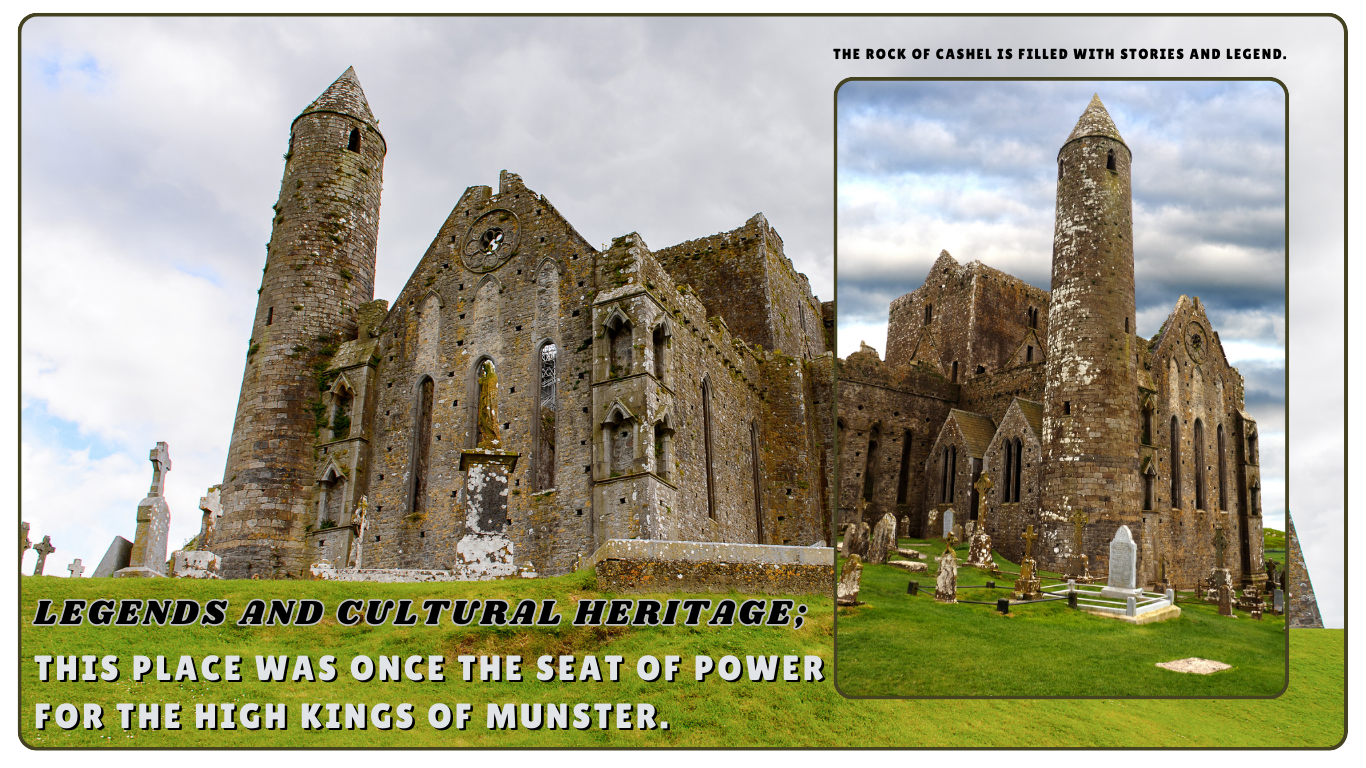
Local Charm and Places to Eat
After visiting the Rock of Cashel, take some time to experience Cashel Town. This heritage town is filled with local accommodation options that will add comfort to your stay. You can find everything from the historic Cashel Palace Hotel with its walled garden and Georgian building, to cozy spots with a bit of luxury like Chez Hans and Mikey Ryan’s Bar & Kitchen. These places serve wonderful Irish breakfasts and other culinary delights.
If you’re looking to explore more, the Cashel Folk Village Museum and Brú Ború cultural center offer a deeper look at Irish life and period interiors. Visiting local shops and restaurants, like Bowes & Co or the Bishop’s Buttery in the Cashel Palace, brings you into contact with independent businesses that give this town its unique character.
To cap off the day, take a walk around Cashel Town to enjoy the mix of fine-dining experiences and relaxed cafes. Many places even offer free parking for visitors. A few more minutes of exploring, and you’ll feel the heartbeat of this charming town, rooted in Irish history but alive with modern comforts.
Key Historical Sites and Must-See Spots Nearby
While exploring Cashel, you’ll find incredible key historical sites and natural beauty all around. A few minutes away, Cashel Folk Village offers a taste of a traditional Irish village, with artifacts that tell stories of the past. Another highlight is Cahir Castle, one of Ireland’s best-preserved medieval castles, which stands strong near the Swiss Cottage and its charming, unique style.
For nature lovers, the Galtee Mountains are a must-see, as are the Knockmealdown Mountains nearby. Both locations offer amazing hiking trails and breathtaking views over lush, green landscapes. The Glen of Aherlow is also close, a valley surrounded by woodlands and perfect for those seeking serene experiences in the Irish countryside. Don’t forget to stop at Mitchelstown Cave with its unique limestone formations and impressive underground rivers.
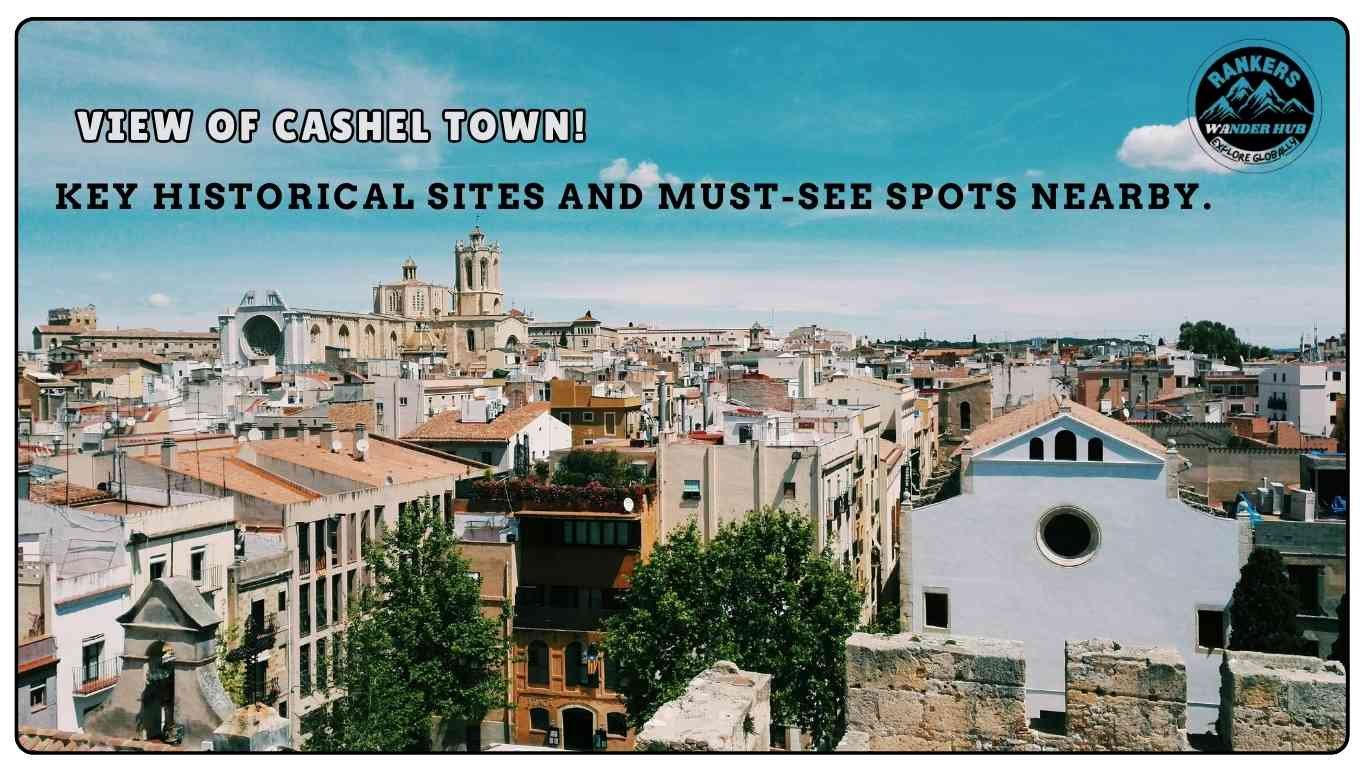
Practical Tips for a Relaxed Visit
To fully enjoy your trip to the Rock of Cashel and surroundings, it’s good to know a few visitor tips. Arriving in the early mornings or during the off-peak season will allow you to explore with fewer tourists around, providing a serene experience. For sunset lovers, sunset photography around the Rock and nearby spots can capture the beautiful colors and peaceful atmosphere.
The Heritage Card is a cost-effective way to explore more of Ireland’s state-managed sites. This includes places like Kilmainham Gaol, Dublin Castle, and Custom House Visitor Centre. There’s also Jerpoint Abbey, offering stunning views and history similar to that of Cashel.
As you explore, remember visitor etiquette is important—being mindful of the historical value and respectful behavior at each site shows appreciation for these precious landmarks. The Rock of Cashel guide and local insights can deepen your understanding of the area’s Irish historical narratives.
Finally, enjoy the rest areas with seating areas and benches scattered around Cashel, perfect for relaxing among green fields after a day of exploring. Each visit to Cashel’s heritage tours and traditional sites promises a mix of history, culture, and stunning natural beauty.

